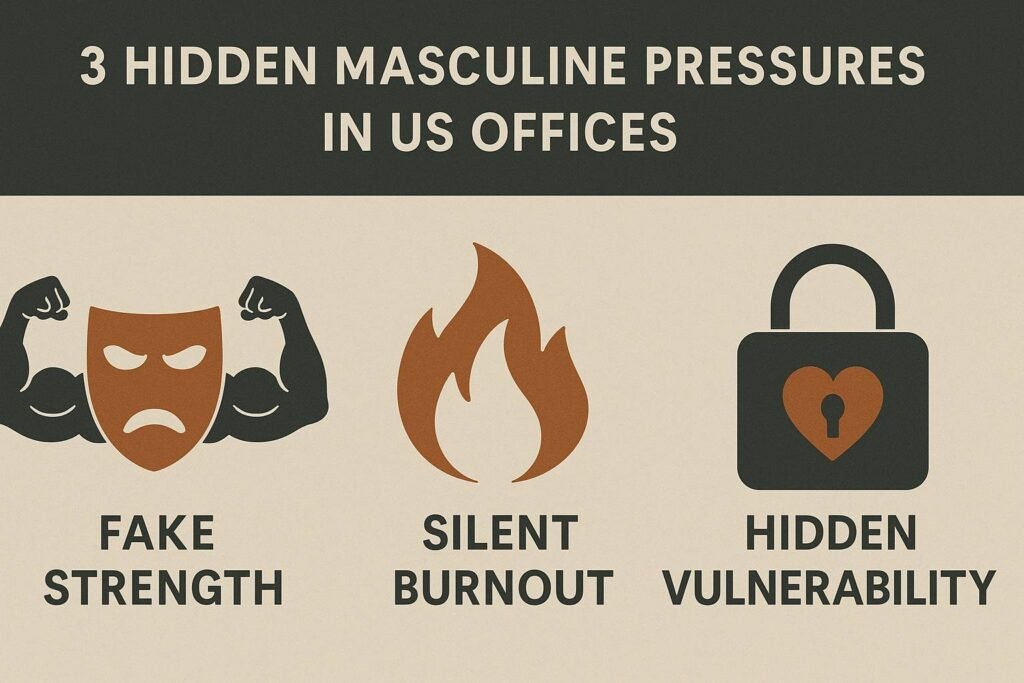INTRODUCTION
Masculine culture in US offices isn’t just a background detail; it’s often the invisible dress code. And we rarely talk about it, maybe because doing so feels like breaking a code of silence passed down from boardrooms to break rooms. But here’s the kicker: behind every “I’m good, just busy” is often a man sprinting toward burnout in business-casual.
I’ve worked with startups fueled by caffeine and raw ambition. I’ve sat through corporate meetings so stiff you’d think smiling required an executive memo. Across both worlds, I noticed the same thing: men performing masculinity like it’s part of the job description. You know the type, straight-backed in meetings, voice low and steady, as if admitting fatigue would demote them instantly.
This article is a brutally honest look at masculine culture in US offices, and why, despite the corner offices and clenched jaws, it’s quietly draining the very people trying to live up to it.
Table of Contents
WHY THIS MATTERS
Masculine culture in US offices doesn’t just show up in loud voices or firm handshakes. It’s in who speaks first. Who never speaks up. Who gets praised for pushing through, even when they’re clearly running on fumes?
According to a 2022 Catalyst report, 73% of men in U.S. workplaces feel pressured to conform to “traditional masculine norms.” Translation? Act tough, stay silent, and for the love of quarterly goals, don’t ask for help. The consequences? Burnout that looks like ambition, overwork that looks like dedication, and emotional distance packaged as “focus.”
Catalyst 2022 report on masculine norms
Let’s not sugarcoat it: this outdated script is shaping entire company cultures, draining innovation, and silently tanking wellbeing. If you care about performance, retention, and, you know, basic humanity, it’s time to challenge what we’re really rewarding.

TRUTH #1: Strength Is Rewarded, Until It’s Not
What it is:
Assertiveness. Decisiveness. Stoicism. Classic masculine traits are often seen as leadership gold. Until they aren’t.
Why it matters:
Go ahead, be “strong”, but not too strong. Don’t speak up too often. Don’t be too quiet either. Don’t smile too much, or people might think you’re soft. It’s a minefield of expectations, where yesterday’s promotion-worthy behaviour becomes today’s “he’s hard to work with.”
How it applies to masculine culture in US offices:
There’s a painfully narrow range of acceptable masculinity in the workplace. Fall outside it, and you’re either “not assertive enough” or “difficult.” Like trying to balance on a chair with two legs and a self-help quote.
Example:
A VP I once worked with confided, “I avoid smiling too much, it makes people think I’ve gone soft.” Imagine spending years mastering your field only to fear… smiling. That’s not leadership. That’s emotional orthodontics.
TRUTH #2: “Alpha” Energy Often Masks Burnout

What it is:
You know that guy who’s always on? Early riser, outworks everyone, speaks with the confidence of a TED Talk and the sleep schedule of a raccoon? He might be winning, or barely holding it together.
Why it matters:
Burnout disguised as “alpha” drive is rampant. Sleep-deprived ambition isn’t noble, it’s dangerous. And in masculine culture, admitting you’re tired feels like weakness. So men keep grinding, keep pretending, until something breaks (usually them).
How it applies:
Many men are performing leadership while secretly drowning. The office becomes less a workplace and more a silent competition of who can carry the heaviest emotional weight without showing a single crack.
Example:
There was a time I bragged about waking up at 4 AM to “optimise my edge.” Turns out, I was just overcompensating for the fact that I didn’t know how to slow down. And ironically, slowing down is what would’ve made me sharper.
TRUTH #3: Vulnerability Is a Risk Few Men Can Afford
What it is:
Want to see a room go quiet? Watch a man in a meeting say, “I’m not sure how to handle this.” Vulnerability, while praised in HR decks, still feels like social suicide in many offices.
Why it matters:
Teams can’t thrive without trust. Trust doesn’t exist without vulnerability. It’s not complicated, it’s just unpopular. The irony? Leaders who dare to be real are often the most respected. But only after they’ve succeeded enough to no longer need anyone’s approval.
How it applies:
Until we normalise vulnerability in real time, not just in carefully crafted LinkedIn posts, men will keep pretending. The cost? Silent suffering, disconnected teams, and emotional health that nosedives quietly.
Stat:
Only 28% of men in corporate roles feel comfortable talking about mental health at work (APA, 2023). That means over 7 in 10 are either bottling it up or waiting for their next PTO day to finally breathe.
APA 2023 Mental Health at Work survey
HOW TO NAVIGATE MASCULINITY AT WORK TODAY

Step 1: Redefine Strength
Strength includes asking for help. It includes saying “I need a break.” And sometimes, it looks like turning your phone off during lunch. Revolutionary, right?
Step 2: Create Micro-Bravery
Try dropping one honest statement in your next meeting. Doesn’t have to be dramatic. Just real. “Honestly, I’m still figuring this out, but here’s what I’m trying.” That kind of truth is contagious.
Step 3: Lead the Unspoken
People don’t follow titles, they follow behaviour. You don’t need a promotion to give your team permission to breathe. Start with yourself.
TOOLS AND PRACTICES FOR INNER GROUNDING
- Journal Prompt: “What part of me am I performing at work, and why?”
- App: Moodnotes – A low-key mood tracker for men who want to feel something but hate the word “journaling.”
- Practice: The 5-5-5 breath (inhale for 5, hold for 5, exhale for 5). Do it before you walk into that back-to-back Zoom marathon.
BONUS: My Framework for Leading Without Posturing
I call it “Calm Presence Leadership.” No chest-pounding. No fire-and-brimstone speeches. Just grounded authority.
- Clarity > Confidence: Speak from what you know, not what you think you should know.
- Listening as Power: People trust those who actually hear them. Not the ones who talk the most.
- Stillness Over Speed: Rush leads to reactivity. Calm allows for strategy. You’re not behind, you’re aware.
True masculine leadership doesn’t perform. It anchors.
FAQ
Q: Is masculine energy always harmful in offices?
No. The problem is when it’s unbalanced or performative. Healthy masculine traits, decisiveness, structure, and vision are powerful when paired with humility.
Q: Can women model these traits too?
Absolutely. Masculine energy isn’t gender-locked. But this article focuses on how these traits uniquely pressure men in U.S. office culture.
Q: What if my office isn’t ready for these conversations?
Start with your circle. You don’t need to lead a revolution, just model a better version.
CONCLUSION
Masculine culture at work isn’t just a topic; it’s a terrain we walk daily. By naming the pressures, we give ourselves the power to choose differently.
Your strength isn’t in the performance. It’s in the presence. And you don’t have to trade clarity for armour.
→ Want to explore more?
Check out: How to Build Unshakable Focus as a Man in a Distracted World
SUGGESTED ARTICLES
Learn how masculine structure, daily rhythm, and purpose-driven action can help you reclaim your attention and operate with clarity, no matter how noisy your environment gets. A natural next step after understanding the mental cost of performative masculinity.
If office culture leaves you drained, you need more than hype. This article explores how disciplined systems, rather than fleeting motivation, can anchor your energy, performance, and confidence.
Dive deeper into the habits and rituals that support masculine mental performance. From morning planning to digital boundaries, this guide shows how structure sets you free.
Corporate life often disconnects men from their biology. This piece brings you back to the fundamentals, how aligning your lifestyle with your hormonal health can supercharge clarity and resilience.
Overcompensating with coffee? This article introduces sustainable energy tactics, designed for high-performing men who want mental clarity without the crash.


